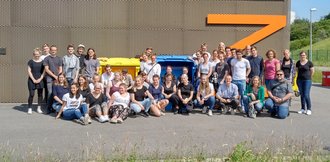Excursion of the Faculty of Civil Engineering to Hamburg
Students of the Faculty of Civil Engineering spent four informative days in and around Hamburg. On the excursion organized by b.is, they gained insights into the practice of recycling management, urban development in HafenCity, resources and energy use.
Tuesday, 11.06.2019, six thirty a.m., it was time to say "Cast off!" and set course for Hamburg, the destination of the Whitsun field trip of the Faculty of Civil Engineering at Bauhaus University Weimar. The fact that b.is[1] took responsibility for the organisation was directly reflected in the interesting programme items of the four-day trip. The first stop on the day of arrival was the „Energieberg“ in Georgswerder, a former landfill. In the 1980s, it hit the headlines after the detection of dioxin in leachate. Today, it‘s remediation is completed and, operated by Stadtreinigung Hamburg, it serves as an energy supply, information centre and viewpoint for the city and its surroundings.
The second day oft he field trip was dedicated to HafenCity - Europe's largest inner-city urban development project. After a presentation of the project with regard to structural, flood protection, energy and urban/traffic planning aspects at the Infocenter, the quarter was explored during a two-hour guided tour. The tour concluded with the presentation of the new Elbbrücken metro station at the eastern end of HafenCity with exciting first-hand insights into planning imponderables, architectural finesse and construction planning tricks given by the project manager.
Day three began with a presentation of the planned Centre for Resources and Energy, which is to be built on the site of the former Stellinger Moor waste incineration plant. The bundling of many processes in one location is intended to increase efficiency and shorten transport routes. Shortening distances also mattered in the formation of the second programme item: the St. Pauli Elbtunnel. Today operated by the Hamburg Port Authority, the two tubes and six elevators on each of the banks were built for the purpose of enabling port workers to cross the northern Elbe reliably and without impairing longitudinal shipping traffic from 1911 onwards. At the same time, a second group of field trip participants visited METHA, a facility for the treatment of excavated harbour sediments. Afterwards, the relaxed part of the day's programme could be enjoyed in predominantly fine weather: two hours of individual harbour tour with a visit to all the facets of shipping Hamburg has to offer.
The fourth and last day of the field trip was dedicated to the subject of "water". Hamburg Wasser presented their Hamburg Water Cycle, a concept based on closed-loop recycling and partial flow treatment, i.e. separate collection and treatment of rainwater, greywater and blackwater in the historic premises of the company. Later, the system was illustrated during a visit to Jenfelder Au, where the system is to be used on a large scale for the first time and where partial components are already in operation. Afterwards, we left for home, filled with diverse impressions.




